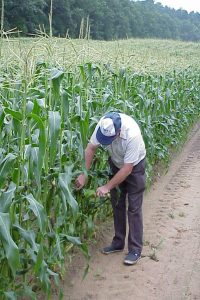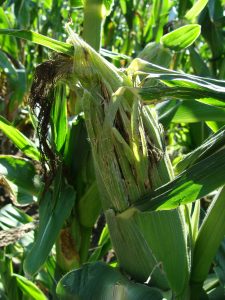Sweet Corn IPM Newsletter No. 10 – August 26, 2022

Sweet Corn IPM Newsletter – No. 10 – August 26, 2022
MODERATE CORN PEST PRESSURE
Silk Sprays Needed for Corn Earworm, Fall Armyworm at Most Sites
Highmoor Farm Twilight Meeting: Thursday, September 8, 5:30-7 p.m. Come join us for a tour of the vegetable variety trials at the Maine Agricultural Experiment Station. Pumpkins, corn, radicchio, celery, artichokes parsnips, carrots, and more will be on display. We are located at 52 US Route 202 in Monmouth.
SITUATION
Insect populations remained relatively stable from last week with moderate numbers for this point in the season. Most fields with silking corn require some protection for earworm and armyworm. Current forecasts are not suggesting any major weather events that would bring more moths into the state for the next week.

European corn borer: Larval feeding injury from corn borer remains low and was not over the 15% control threshold for pre-tassel corn at any of our scouting sites. Moth captures were inconsistent, similar to last week, but generally lower overall. Counts were over the 5-moth threshold for silking corn in Bowdoinham, Lewiston, and Oxford. All of these sites were on a spray interval for corn earworm, so no additional sprays were recommended.
Corn earworm: Moth counts declined at most locations this week but are high enough to continue spray intervals for silking corn at most locations. A 6-day spray interval for silking corn was recommended in Biddeford, Dayton, and Sabattus. A 5-day spray schedule was recommended for Bowdoinham, one Lewiston site, Monmouth, Oxford, Palmyra, Wayne, and one Wells site. A 4-day spray interval was recommended in Cape Elizabeth, one Lewiston site, New Gloucester and one Wells site.
Fall armyworm: Fall armyworm moth counts were generally lower week, and its distribution remains variable. Trap counts were over the three-moth threshold for silking corn in Biddeford, Bowdoinham, one Dayton site, one Lewiston site, Monmouth, New Gloucester, Oxford, and Wells. With the exception of the Dayton site, all of these locations are on a spray interval for corn earworm, so additional sprays should not be needed. A single spray for silking corn was recommended in Dayton. Larval feeding damage on leaves and tassels of younger corn was over threshold in several locations, and growers should continue to scout younger fields for injury. Sprays for feeding damage were recommended in Bowdoinham and Cape Elizabeth.
Western bean cutworm: Numbers continue to fall this week, with many sites not catching any moths. The highest numbers were in western Maine, and no traps had more than 8 moths. Fields under a spray interval for corn earworm will also be protected against this pest.

Birds, etc.: Flocking species of blackbirds are starting to cause damage in cornfields around the state. Birds may to be more of a problem in dry years, when food and water is more difficult to find. They are especially attracted to fields where corn has been allowed to get over-mature. Deer, skunks and raccoons have also been troublesome this year. For information on wildlife problems and management options, you may call the APHIS office in Augusta at 1-866-487-3297.

Highmoor Farm Twilight Meeting: Thursday, September 8, 5:30-7 p.m. Come join us for a tour of the vegetable variety trials at the Maine Agricultural Experiment Station. Pumpkins, corn, radicchio, celery, artichokes parsnips, carrots and more will be on display. We are located at 52 US Route 202 in Monmouth.
Sincerely,
David T. Handley
Vegetable and Small Fruit Specialist
Highmoor Farm UMaine Extension Diagnostic
P.O. Box 179 Research Lab, Pest Mgmt. Unit
52 U.S. Route 202 17 Godfrey Drive
Monmouth, ME 04259 Orono, ME 04473
207.933.2100 1.800.287.0279
Sweet Corn IPM Weekly Scouting Summary
| Location | CEW
Moths |
ECB
Moths |
FAW
Moths |
%Feeding
Damage |
Recommendations / Comments |
| Biddeford | 2 | 0 | 10 | 11% | 6-day spray interval for silking corn |
| Bowdoinham | 6 | 8 | 12 | 28% | 5-day spray interval for silking corn |
| Cape Elizabeth | 8 | 0 | 2 | 18% | 4-day spray interval for silking corn |
| Dayton I | 2 | 0 | 0 | 6-day spray interval for silking corn | |
| Dayton II | 1 | 0 | 4 | 3% | One spray on silking corn for FAW |
| Farmington | 0 | 4 | 1 | No spray recommended | |
| Garland | 1 | 0 | 0 | 0% | No spray recommended |
| Lewiston | 6 | 5 | 0 | 5-day spray interval for silking corn | |
| Lewiston II | 9 | 3 | 7 | 4-day spray interval for silking corn | |
| Monmouth | 4 | 3 | 6 | 5-day spray interval for silking corn | |
| New Gloucester | 36 | 2 | 14 | 3% | 4-day spray interval for silking corn |
| Oxford | 4 | 7 | 7 | 11% | 5-day spray interval for silking corn |
| Palmyra | 3 | 0 | 0 | 0% | 5-day spray interval for silking corn |
| Sabattus | 2 | 3 | 1 | 6-day spray interval for silking corn | |
| Wayne | 7 | 0 | 0 | 5-day spray interval for silking corn | |
| Wells I | 7 | 0 | 4 | 5-day spray interval for silking corn | |
| Wells II | 9 | 0 | 10 | 12% | 4-day spray interval for silking corn |
CEW: Corn earworm (Only fresh silking corn should be sprayed for this insect.)
ECB: European corn borer
FAW: Fall armyworm
| European Corn Borer Thresholds
Whorl stage: 30% or more of plants scouted show injury. Pre-tassel-silk: 15% or more of plants scouted show injury. Silk: 5 or more moths caught in pheromone traps in one week. |
Corn Earworm Spray Thresholds for Pheromone Traps
| Moths caught per week | Moths caught per night | Spray interval |
| 0.0 to 1.4 | 0.0 to 0.2 | No spray |
| 1.5 to 3.5 | 0.3 to 0.5 | Spray every 6 days |
| 3.6 to 7.0 | 0.6 to 1.0 | Spray every 5 days |
| 7.1 to 91 | 1.1 to 13.0 | Spray every 4 days |
| More than 91 | More than 13 | Spray every 3 days |
Thresholds apply only to corn with exposed fresh silk. Lengthen spray intervals by
one day if maximum daily temperature is less than 80°F.
IPM Web Pages:
http://extension.umaine.edu/ipm/
http://www.pestwatch.psu.edu/sweet_corn.htm
https://ag.umass.edu/integrated-pest-management/
https://nevegetable.org/crops
Where brand names or company names are used, it is for the reader’s information. No endorsement is implied nor is any discrimination intended against other products with similar ingredients. Always consult product labels for rates, application instructions and safety precautions. Users of these products assume all associated risks.
The University of Maine is an equal opportunity/affirmative action institution.
